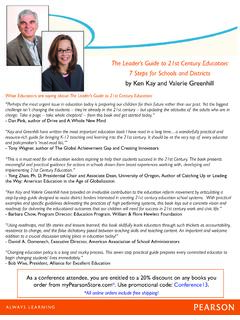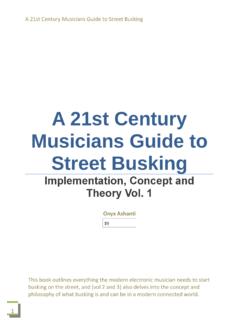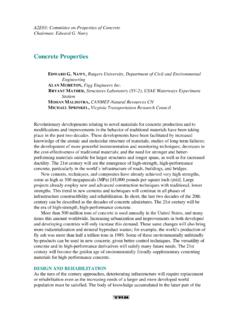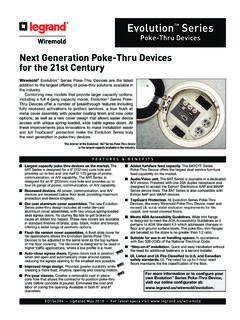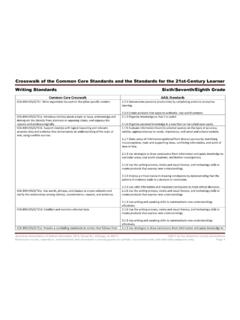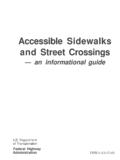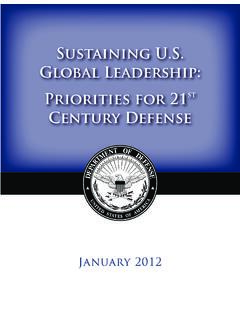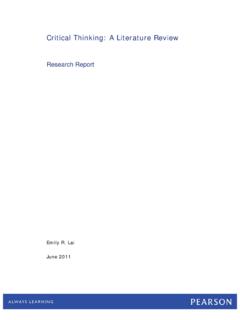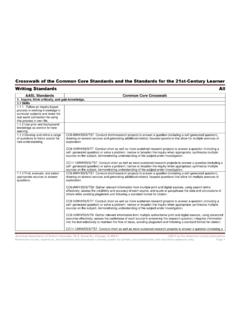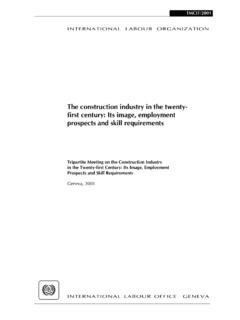Transcription of 21 Century Soldier Competencies
1 Slide 1 1 Character and accountability Comprehensive fitness Adaptability and initiative Lifelong learner (includes digital literacy) Teamwork and collaboration Communication and engagement (oral, written, negotiation) Critical thinking and problem solving Cultural and joint, interagency, intergovernmental, and multinational competence Tactical and technical competence (full spectrum capable)21stCentury Soldier Competencies Method of Instruction: CO Facilitator to Student Ratio: 1:25 Time of Instruction: 30 minutes Media: Power point BLOCK AUTHOR: Mr. Michael R. Langston Sr. LESSON AUTHOR: Mr. Scott M. Clouse DATE PREPARED: 10 December 2014 LAST REVISION: 30 December 2014 LEARNING OUTCOME: The goal of this course is to provide the students with the foundation necessary to communicate effectively through written communication, including memos, papers, and e-mail communication. This lesson will provide information relating to Army writing that will prepare the RRNCO for additional leadership responsibilities as well as higher level training.
2 At the conclusion of this lesson, students should be able to recognize common grammatical errors and ambiguous statements. This training should lead students to understand how those errors impact their writing and how others view them as an effective RRNCO. Students should also be able to produce basic Army communications that are clear, concise, and contain minimal grammatical errors. This lesson will address the following 21st Century Soldier Competencies : - Communication and engagement: Understanding the content of this lesson will allow Soldiers and leaders to express themselves more clearly and succinctly in various written forms of communications. - Lifelong Learner: This lesson supports lifelong learning by having Soldiers assess their own writing and determine areas of their writing and overall communication skills where they need to improve. Understanding the need for improved communication skills will improve their effectiveness as a Soldier and a leader.
3 ASSIGNED READING: AR 25-50, TRADOC Reg 1-11 ASSIGNED HOMEWORK: N/A INSTRUCTOR ADDITIONAL READINGS: N/A CLASSROOM AIDS REQUIRED: Facilitator Note: Incorporate the political, military, economic, social, infrastructure, and physical environment and time (PMESII & PT) into each lesson and classroom work as appropriate. Facilitator will illustrate them with appropriate examples from the Operating Environment (OE) as it pertains to the lesson. Safety Requirements: In a training environment, leaders must perform a risk assessment in accordance with FM 5-19, Composite Risk Management. Leaders will complete a DA Form 7566 Composite Risk management Worksheet during the planning and completion of each task and sub-task by assessing mission, enemy, terrain and weather, troops and support available-time available and civil considerations, (METT-TC). Risk Assessment: Low : Environmental related risk assessment: No food or drink allowed near or around electrical equipment (CPU, file servers, printers, projectors, etc.)
4 Due to possible electrical shock or damage to equipment. Exercise care in personal movement in and through such areas. Avoid all electrical cords and associated wiring. In the event of an electrical storm, you may be required to power down. Use precautions with electrical equipment during thunderstorms / electrical. Environmental Considerations: Facilitator should conduct a risk assessment to include environmental considerations IAW FM , Environmental Considerations (MCRP 4-11B), and ensure students are briefed on hazards and control measures. Environmental protection is not just the law but the right thing to do. It is a continual process and starts with deliberate planning. Always be alert to ways to protect our environment during training and missions. In doing so, you will contribute to the sustainment of our training resources while protecting people and the environment from harmful effects. Refer to FM 3-34-5 Environmental Considerations and GTA 05-08-002 ENVIORNMENTAL RELATED RISK ASSESSMENT.
5 Foreign Disclosure: FD1, No limitations. Evaluation: The knowledge gained in this lesson will be tested through the preparation of a memo with enclosures. Students must successfully prepare a memo THRU that is written and formatted IAW AR 25-50 in order to receive a GO . concrete Experience: concrete Experience Instruction: Instructor should have had students respond to REMIND ME application invite on Day 1 ( ). NOTE: If this is ever an issue, the instructor can just send an email. Just ensure the students check emails one last time at 2000 each night. The night before the LP is presented. the instructor will send a text that breaks all the communication rules discussed in this LP. The Instructor must avoid all questions regarding the sent text until the class starts the next day. Example of text to send to students: Sudents, b sure to come peppered tomorrow as we have a long day of construction. Also, please bring your caps for an exercise in class.
6 Students will likely respond with questions for clarification of meaning or regarding what cap they are supposed to bring. If nothing else, they will likely be laughing at the instructor because of the auto corrections. When class starts the next day, ask students if they received the text the night before. Ask if they came prepared. They should express that the text was unclear. Play a long for a while as though you don t know the text was unclear or don t accept their excuse that it wasn t clear. Allow students to express confusion (maybe even frustration) over the text by further bringing to your attention how poorly it was written. After sufficient discussion, then go into the Publish phase where you reveal to students that they were set up. ASK: Facilitator Note: Facilitate discussion with the students, below are questions to guide you in this facilitation. Publish: What were your first thoughts when you received the text?
7 What did you find most confusing about the text? How did you respond when you couldn t get clarification from the instructor? Without clarification, how did you prepare for class anyway? How did the poorly written text affect your confidence about being properly prepared? How did the badly written text affect your image of me as an Instructor? Process: As an RRNCO, how often are your required to send texts, emails and written correspondence? Why is it important to be able to write and format information correctly? Have you ever experienced a similar situation with someone else s poorly written correspondence? How did that written communication affect your image of that person, especially if it was someone you had never met before? Have you ever pressed the send button without proofreading and regretted it later, including sending it to the wrong person? That s what this block is about, putting the best YOU out there when it comes to written communication, be it text, email or written.
8 Slide 2 Action:Develop Army Writing SkillsCondition:In a classroom environment with access to AR 25-50, TRADOC Reg1-11, and RWS. 2 Terminal Learning Objective TLO Action Develop Army Writing Skills Condition In a classroom environment with access to AR 25-50 and RWS. Slide 3 3 Terminal Learning ObjectiveStandard:Students will construct a Memo with Enclosures that demonstrates the use of the skills presented in this lesson. Students will also be responsible for using these skills to produce and submit a target market plan and to evaluate a unit retention environment. All written documents must be completed IAW AR 25-50 and the grading rubric. TLO Standard: Students will construct a Memo with Enclosures that demonstrates the use of the skills presented in this lesson. Students will also be responsible for using these skills to produce and submit a target market plan and to evaluate each of their units retention environment.
9 All written documents must be completed IAW AR 25-50 and the grading rubric. Note: Connect the TLO to the concrete Experience. Say: So would you say the beginning of this lesson actually happened last night? Hopefully you see the importance of always looking professional and communicating clearly, regardless of how small the information may be. It is a reflection of you AND the National Guard at work! Since email is probably our most used methods of communication, let s look at some examples. Slide 4 4 Excerpt from Communications guidelines for Environmental Resources Engineering (ERE) Department of Environmental Resources Engineering, State University of New York College of Environmental Science and Forestry, 402 Baker Labs, Syracuse, NY 13210 Slide 4 Discuss writing professional e-mails. GENERALIZE NEW INFORMATION (GNI) Learning/Step Activity One Facilitator Note: Give the students time to review Figure 1, then facilitate a discussion using the questions below as a guide.
10 Q. What is your first impression after reading this e-mail? Would you provide this student a reference? Why or why not? Possible responses or topics to discuss: I would not be able to provide a reference to this student. The student did not provide a name or signature block in the email, so unless there is enough information in the e-mail address for the recipient to identify the sender, it would be difficult to determine who the sender is, and therefore, difficult to write a recommendation for the sender. Did you notice that there is no subject line or greeting to the email? Did you also notice the spelling errors? ( refernce instead of reference) What about the use of contractions? (you d, i d instead of you would or I would) What about the lack of capitalization? Given all these issues, would you want to put your reputation as a professional on the line by providing this person a reference? Slide 5 5 SLIDE 5 Discuss the Army Writing Style Facilitator Note: Give the students time to review Figure 1, then facilitate a discussion using the questions below as a guide.
